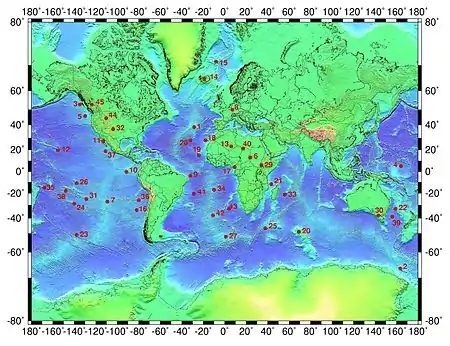Marquesas hotspot
The Marquesas hotspot is a volcanic hotspot in the southern Pacific Ocean. It is responsible for the creation of the Marquesas Islands – a group of eight main islands and several smaller ones – and a few seamounts. The islands and seamounts formed between 5.5 and 0.4 million years ago and constitute the northernmost volcanic chain in French Polynesia.[1]

There are two competing theories concerning the origins of volcanism associated with the Marquesas hotspot. Many geoscientists maintain that the area is underlain by a mantle plume which has transported hot material from the lower mantle to the surface, forming the chain of islands and seamounts as the Pacific Plate moved in a north-westerly direction relative to the stationary plume.[2][3][4][5] Radiometric dating of the youngest volcanic rocks suggests that volcanism is still active.[6] Evidence for a plume origin comes mainly from seismic imaging, with large-scale low velocity anomalies being observed from the core-mantle boundary to around 1000 km depth and interpreted as a superplume, and smaller, shallow anomalies interpreted as narrow secondary plumes generated by the superplume.[7][8][9] Geochemical analysis of the lavas has also been argued to favour a deep-mantle source,[4][10] though the extent to which source depth can be determined by lava geochemistry has been disputed.[11]
Some features of the Marquesas, such as the trend of the islands and seamounts, non-fixity of the source, and short-lived volcanic activity, have been argued to conflict with the plume model.[12] The trend of the chain and non-fixity of the source, however, may be explained by the plume conduit either being deflected by convection currents in the upper mantle[9][13] or melt being channelled through zones of structural weakness.[6] Volcanic activity may be much longer-lived if the plume also created Hess Rise and Shatsky Ridge to the northwest, both of which follow the same trend as the Marquesas and are dated at 100 Ma and 145–125 Ma respectively.[2]
Nevertheless, some scientists dispute the plume model, arguing instead that volcanic activity associated with the Marquesas hotspot and others in the southern Pacific results from shallow tectonic processes. In this interpretation, volcanism in the Marquesas is a consequence of intraplate stresses caused primarily by reorganisations of plate boundaries and thermal contraction of the lithosphere. These processes, it is argued, have generated a system of fissures which enable pre-existing melt in the crust and upper mantle to escape to the surface.[14][15][11][16] The primary evidence for this interpretation is the timing of volcanic activity and orientation of the Marquesas chain, which coincide closely with major reorganisations of plate boundaries and consequent changes in the lithospheric stress field.[11]
See also
References
- Neall, V.E.; Trewick, S.A. (2008). "The age and origin of the Pacific islands: A geological overview". Philosophical Transactions of the Royal Society of London B. 363 (1508): 3293–3308. doi:10.1098/rstb.2008.0119. PMC 2607379. PMID 18768382.
- Clouard, V.; Bonneville, A. (2001). "How many Pacific hotspots are fed by deep-mantle plumes?". Geology. 29 (8): 695. Bibcode:2001Geo....29..695C. doi:10.1130/0091-7613(2001)029<0695:HMPHAF>2.0.CO;2.
- Koppers, A.A.P.; Staudigel, H.; Pringle, M.S.; Wijbrans, J.R. (2003). "Short‐lived and discontinuous intraplate volcanism in the South Pacific: Hot spots or extensional volcanism?". Geochemistry, Geophysics, Geosystems. 4 (10): 1089. Bibcode:2003GGG.....4.1089K. doi:10.1029/2003GC000533. S2CID 131213793.
- Legendre, C.; Maury, R.C.; Blais, S.; Guillou, H.; Cotton, J. (2006). "Atypical hotspot chains: Evidence for a secondary melting zone below the Marquesas (French Polynesia)". Terra Nova. 18 (3): 210–216. Bibcode:2006TeNov..18..210L. doi:10.1111/j.1365-3121.2006.00681.x. S2CID 129026746.
- Chauvel, C.; Maury, R.C.; Blais, S.; Lewin, E.; Giullou, H.; Guille, G.; Rossi, P.; Gutscher, M-A. (2012). "The size of plume heterogeneities constrained by Marquesas isotopic stripes". Geochemistry, Geophysics, Geosystems. 18 (3): 210–216. Bibcode:2012GGG....13.7005C. doi:10.1029/2012GC004123.
- Révillon, S.; Guillou, H.; Maury, R.C.; Chauvel, C.; Aslanian, D.; Pelleter, E.; Scao, V.; Loubrieu, B.; Patriat, M. (2017). "Young Marquesas volcanism finally located". Lithos. 294–295: 356–361. Bibcode:2017Litho.294..356R. doi:10.1016/j.lithos.2017.10.013. S2CID 134538446.
- Isse, T.; Suetsugu, D.; Shiobara, H.; Sugioka, H.; Yoshizawa, K.; Kanazawa, T.; Fukao, Y. (2006). "Shear wave speed structure beneath the South Pacific superswell using broadband data from ocean floor and islands". Geophysical Research Letters. 33 (16). Bibcode:2006GeoRL..3316303I. doi:10.1029/2006GL026872. hdl:2115/52170.
- Suetsugu, D.; Isse, T.; Tanaka, S.; Obayashi, M.; Shiobara, H.; Sugioka, H.; Kanazawa, T.; Fukao, Y.; Barruol, G.; Reymond, D. (2009). "South Pacific mantle plumes imaged by seismic observation on islands and seafloor". Geochemistry, Geophysics, Geosystems. 10 (11): n/a. Bibcode:2009GGG....1011014S. doi:10.1029/2009GC002533. S2CID 52267924.
- French, S.W.; Romanowicz, B. (2015). "Broad plumes rooted at the base of the Earth's mantle beneath major hotspots". Nature. 525 (7567): 95–99. Bibcode:2015Natur.525...95F. doi:10.1038/nature14876. PMID 26333468. S2CID 205245093.
- Castillo, P.R.; Scarsi, P.; Craig, H. (2007). "He, Sr, Nd, and Pb isotopic constraints on the origin of the Marquesas and other linear volcanic chains". Chemical Geology. 240 (3–4): 205–221. Bibcode:2007ChGeo.240..205C. doi:10.1016/j.chemgeo.2007.02.012.
- Natland, J.H.; Winterer, E.L. (2005). "Fissure control on volcanic action in the Pacific". In Foulger, G.R.; Natland, J.H.; Presnall, D.C.; Anderson, D.L. (eds.). Plates, plumes, and paradigms: Geological Society of America Special Paper 388. Geological Society of America. pp. 687–710. doi:10.1130/0-8137-2388-4.687. ISBN 9780813723884.
- Anderson, D.L. (2005). "Scoring hotspots: The plume and plate paradigms". In Foulger, G.R.; Natland, J.H.; Presnall, D.C.; Anderson, D.L. (eds.). Plates, plumes, and paradigms: Geological Society of America Special Paper 388. Geological Society of America. pp. 31–54. doi:10.1130/0-8137-2388-4.31. ISBN 9780813723884.
- Zhao, D. (2001). "Seismic structure and origin of hotspots and mantle plumes". Earth and Planetary Science Letters. 192 (3): 251–265. Bibcode:2001E&PSL.192..251Z. doi:10.1016/S0012-821X(01)00465-4.
- Hieronymus, C.F.; Bercovici, D. (2000). "Non-hotspot formation of volcanic chains: Control of tectonic and flexural stresses on magma transport". Earth and Planetary Science Letters. 181 (4): 539–554. Bibcode:2000E&PSL.181..539H. doi:10.1016/S0012-821X(00)00227-2.
- Smith, A.D. (2003). "A reappraisal of stress field and convective roll models for the origin and distribution of Cretaceous to recent intraplate volcanism in the Pacific basin". International Geology Review. 45 (4): 287–302. Bibcode:2003IGRv...45..287S. doi:10.2747/0020-6814.45.4.287. S2CID 129463020.
- Peive, A.A. (2007). "Linear volcanic chains in oceans: Possible formation mechanisms". Geotectonics. 41 (4): 281–295. Bibcode:2007Geote..41..281P. doi:10.1134/S0016852107040024. S2CID 128409663.